Long-term investments aren’t quite as enticing as shorter, more volatile ones. They don’t require fast thinking or a genius-level intellect to manage. They’re rarely talked about in television programs or movies. In fact, they’re rarely talked about at all outside of HR offices and financial planning firms.
But when it comes to building stable, generation-spanning wealth, investing for the long term is the gold standard. That’s because when an investment is allowed to mature over the course of decades, it reaps the benefits of compound interest. In other words, the interest earned by your portfolio begins to earn interest on itself.
So if you’re thinking about starting a portfolio—or looking to fine-tune the one you have—the beginning of the year is a great time to start. Here are some of the best options to consider for 2021.
What are long-term investments?
A long-term investment is one that you don’t touch for at least 10 years. In some cases, that period may stretch to as long as 40 years. With a long-term investment, you hold your position and don’t sell until the appropriate time, even if the value falls drastically.
Long-term investments are appropriate for far-off goals like retirement or a child’s college education. They’re not as useful for short-term goals like buying a house in the near future or paying for a wedding next spring.
The only difference between a short-term and a long-term investment is how long you hold it. For example, you can buy Disney stock today and keep it for 20 years, making it a long-term investment. You can also buy that same stock and sell it in six months, making it a short-term investment.
Different investments are better suited for long or short-term growth. Ideally, long-term investments provide a balance between growth and risk. Stocks have the potential to grow very quickly, but they can be too risky for long-term investment. At the same time, avoiding any risk at all will make it very difficult to grow your portfolio adequately.
A long-term investment should grow enough to support your goals. At the very least it should outpace inflation, which is usually between 2 and 3%. If you save for the long term in a savings account with a 1.5% interest rate, inflation will exceed the interest return. That’s why keeping your retirement fund in a savings account, even if it’s high-yield, is a bad idea.
Where to put long-term investments
Long-term investments are usually held in retirement accounts such as Roth and traditional IRAs, Roth and traditional 401(k)s, and 403(b)s. Anyone can open an IRA, while a 401(k) or 403(b) has to be provided by your employer.
If you’re saving for a child or grandchild’s college education, a 529 account is probably more appropriate. This is a special savings account that provides tax benefits when you use the funds for qualified education expenses like tuition, books, and college housing.
Brokerage accounts may also be used for long-term investing, but they’re only a good choice in some situations. They do have fewer rules than retirement accounts, but they also don’t have any tax incentives.
If you’re saving for a vacation home to buy in 20 years, a brokerage account may be better than an IRA or 401(k) because you won’t be penalized for withdrawing funds before age 65. Most investors saving for retirement shouldn’t open a brokerage account unless they’ve already maxed out their IRA or 401(k).
Health Savings Accounts (HSA) are another popular vehicle for long-term investments. Like their name, HSAs are where consumers can save money for medical expenses. HSA contributions are tax-deductible, and funds can be withdrawn tax-free.
Once you have a certain amount in an HSA, usually between $1,000 and $2,000, you can invest that money in mutual funds and ETFs.
HSAs are great for long-term investing because earnings grow tax-free and can be used for medical expenses at any time. You can withdraw the money for any reason once you reach 65 years old, but you will owe a standard income tax on the sum you withdraw.
Best long term investments for 2021
If you’re ready to start investing for the long-term, check out these top picks:
1. S&P 500 index fund
For decades, the S&P 500 has been the standard against which other stocks and funds are measured. That’s why investing experts love S&P 500 index funds.
“You can do very well if you just buy and hold a low-cost S&P 500 index fund,” said Ryan Sterling, founder of Future You Wealth.
This index fund follows the S&P 500 index, which includes the 500 largest publicly-traded companies in the U.S. Since its inception in 1957, the S&P 500 has averaged about 8% annually.
Most S&P 500 index funds have low fees, an important perk for long-term investing. Financial planner Dejan Ilijevski, President of Sabela Capital Markets, said high fees can kill any portfolio.

“It’s important to remember that costs do not correlate with returns,” he said. “In fact, the lower your costs, usually the higher will be your expected returns.”
2. Bond funds
Every investor who’s saving for retirement, no matter their age, should have a bond fund in their portfolio. A bond fund contains a variety of bonds from both corporate and government sources. The government bonds in a bond fund should include both local and federal government bonds.
Bond funds provide balance to a portfolio. When stock funds do well, bonds usually don’t. But when stock funds tumble, bonds pick up the slack. In general, bonds are stable and almost never experience large swings in value.
Investors decades away from retirement should have between 10 to 20% of their portfolio in a bond fund, while those only five or 10 years out may have the majority in bonds.
An easy way to decide how much to invest in a bond fund is by using your age. If you’re 30, your portfolio should be around 30% bond funds. If you’re 45, then approximately 45% of your portfolio should be in bond funds.
Most reputable bond funds also have low fees, so you won’t pay extra for the security bonds provide. Look for bond funds with an expense ratio of .5% or less.
3. Total stock market fund
A total stock market fund is similar to an S&P 500 index fund, but with some key differences. Both funds have large-cap companies, but a total stock market fund also has some small and mid-cap companies.
The inclusion of these smaller companies is important, because small and mid-cap companies are typically younger, and therefore tend to have more growth potential than large-cap companies. When you invest in a total stock market fund, you’re getting exposure to a wider swath of companies.
Like S&P 500 index funds, total stock market funds also tend to have low fees. They also yield similar returns to the S&P 500 index.
4. Target-date fund
Some investors love to get their hands dirty, checking on stocks daily and tracking the progress of their portfolio from every angle. Other people know they should invest, but prefer a more laid-back approach.
Anyone with a more hands-off approach to investing should consider target-date funds, which are designed to set it and forget it. You put money in a target-date fund, let it simmer for 30 years and only withdraw once you’re ready. Most people use target-date funds for their retirement account.
Target-date funds hold a mix between stock and bond funds. If you pick a target-date fund as a twentysomething, the fund will be mostly made up of stock funds. As you get older, the fund will start to replace some of those stock funds with more bond funds.
Target-date funds take the guesswork out of investing. Consumers don’t have to worry about rebalancing their portfolio because the target-date fund does it automatically.
Target-date funds come in five-year increments, and are named after the year you’re aiming to withdraw. For example, if you want to retire in 2053, you’d pick a 2055 target-date fund.
This service doesn’t come cheap. Target-date funds have higher fees than some index funds, with average fees of .51%. In contrast, an S&P 500 index fund may have a less than .1% fee structure. Target-date fund fees are still relatively small, however, and lower than many actively managed funds. If the ability to sit back and let your nest egg grow with little fuss is important to you, this slight upcharge may be worth the price.
Some brokerage firms have low fees on target-date funds, closer to what you’d pay with an S&P 500 index fund. Before picking a target-date fund from a particular brokerage, compare it to what’s offered by other firms to find a low-fee offering.
Why you should beware of individual stocks for long-term investing
Individual stocks have huge growth potential. For many, it’s the only way to invest for the long term. The problem is, stocks are inherently risky. When you put money in one company, your financial success depends on that company’s growth.
When you invest in an index fund, on the other hand, one company’s success or failure has little impact. If one company drops 50% in a day, it would be a small blip in an index fund spread out between hundreds of companies.
Financial planners are wary of recommending individual stocks for long-term investing. According to Mark Setee, CFP and advisor at Wealthsimple, no one should have more than 5% of their total portfolio in stocks.
“This way, if the stock goes up, great,” he said. “If not, the stock isn’t going to sink your ship financially.”
If you decide to take on individual stocks, you’ll need to take an active role in managing them. That’s because, unlike an index fund, the ups and downs of a single stock can have far-reaching implications for your portfolio. Many people don’t want to monitor their investments this closely, or don’t have the financial education to know what they’re looking for.
“If you invest in an individual stock, you have to pay more attention to this company’s financial reports, management changes, product changes, etc. as well as the industry background and the relevant laws and regulations,” said Dora Waters, Registered Investment Advisor and President of DP Waters Wealth Management LLC.
This is why index funds, with their ease and simplicity, are such a popular choice.
